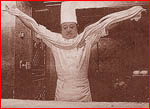Special/Noodle
Chinese Noodle
 Noodles occupy an important position in Chinese cuisine.
Actually, the Chinese were the inventors of noodles, and they were brought to the European noodle country, Italy, by Marco Polo only in the 13th century.
Noodles occupy an important position in Chinese cuisine.
Actually, the Chinese were the inventors of noodles, and they were brought to the European noodle country, Italy, by Marco Polo only in the 13th century.
Unlike the Italians who can't explain why their spaghetti are long the Chinese do have a seemingly very logical reason why the longer the noodles are the better. To some of the ever superstitious Chinese long noodles mean long life.
Making noodles the traditional Chinese way is an acrobatic art. The dough is pulled and whirled through the air in order to stretch it through centrifugal force; but today machines use other techniques.
There are two kinds of noodles in Chinese cuisine, egg noodles or mien, and rice noodles or bijon (in English sometimes referred to as glass noodles because they
just look like they were made of glass). Whereas egg noodles are mostly in the shape of thin spaghetti, rice noodles are also commonly served as ho fan (wide noodles like the Italian fettuccine and tagliatelle).
In Chinese cuisine, noodles can be served three ways: in a clear soup with meat and some vegetables, or mixed with meat and with a thickened sauce poured over or without sauce; whereas for noodles with sauce egg noodles (mien) are commonly used, it's bijon noodles if served without sauce.
Egg noodle dishes with sauce appear on Chinese menus with English translations often specified as fried. This is grossly misleading as they are mostly just barely
sauted. There is nothing crisp in such a "fried" dish, and the rather tasteless cornstarch sauce gives the dish a porridge texture.
|